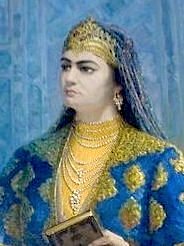music.wikisort.org - Poet
Mohlaroyim (Uzbek: Mohlaroyim, Моҳларойим; 1792–1842), most commonly known by her pen name Nodira, was an Uzbek poet and stateswoman.[1] She functioned as regent of the Khanate of Kokand during the minority of her son from 1822.
| Nodira | |
|---|---|
 | |
| Born | Mohlaroyim 1792 Andijan |
| Died | 1842 Kokand |
| Issue | Madali Khan Sultan-Mahmud |
| Religion | Islam |
| Occupation | Poet and stateswoman |
Nodira is generally regarded as one of the most outstanding Uzbek poets.[2] She wrote poetry in Uzbek and Persian. Nodira also used other pennames, such as Komila and Maknuna.[3] Many of her diwans have survived and consist of more than 10,000 lines of poetry.[4]
Biography
Nodira was the wife of Muhammad Umar Khan who ruled the Khanate of Kokand from c. 1810 until his death in 1822.[5] Following her husband's death, Nodira became the de facto ruler of Kokand since her son Muhammad Ali Khan was only a teenager when he was crowned Khan; she continued to be a regent and advisor to him throughout his reign. She was also poetess who knew Persian and Uzbek and would write her poetry both in Uzbek and Persian. Her work consisted of 10,000 hemistiches. [6]
Despite her attempts to instill somewhat more socially liberal values into her son, Madali grew to employ expansionist policies that lead to a war with the rival Emirate of Bukhara. Her poetry was frowned upon by the ulama and was deemed "inappropriate", with her writing often bringing up taboo topics and bemoaning the suffering women faced in Central Asia in that time period.[3][7]
She was hanged on the order of Emir Nasrullah Khan of Bukhara in April 1842 along with her sons during the Kokand-Bukhara wars. It was reported Nasrullah was reportedly furious that she refused to marry him.[3][8][9][10]
Legacy
Long after her death in 1842 Nodira was promoted in the Soviet era as a national heroine of the Uzbek SSR and enjoyed a status similar to other murdered women such as Nurkhon Yuldasheva. In the public eye she is a martyr and national heroine, and 200 years after her birth, the first national postage stamp of newly independent Uzbekistan featured her portrait.[11][12]
References
- Qodirova, Mahbuba (2005). "Nodira" [National Encycolopedia of Uzbekistan]. Oʻzbekiston milliy ensiklopediyasi (in Uzbek). Toshkent.
- "Uzbek Literature". Encyclopædia Britannica. Retrieved 1 March 2013.
- Qodirova, Mahbuba. "Nodira (1792-1842)". Ziyouz (in Uzbek). Retrieved 17 October 2014.
- "Nodira – Komila (1792-1842)".
- "Nodira". Ensiklopedik lugʻat (in Uzbek). Vol. 2. Toshkent: Oʻzbek sovet ensiklopediyasi. 1990. p. 20. 5-89890-018-7.
- "Nodira – Komila (1792-1842)".
- Hanks, Reuel R. (2005). Central Asia: A Global Studies Handbook. ABC-CLIO. pp. 138. ISBN 9781851096565.
- Starr, S. Frederick (2014-12-18). Ferghana Valley: The Heart of Central Asia. Routledge. p. 34. ISBN 9781317470663.
- Rahul, Ram (2000). March of Central Asia. Indus Publishing. p. 140. ISBN 9788173871092.
- "Nodira Beg". eurasia.travel. Retrieved 2018-06-11.
- "Grandpoohbah's Blog: Nodira Mohlaroyim". Retrieved 2017-12-22.
- Smith, Graham (1998-09-10). Nation-building in the Post-Soviet Borderlands: The Politics of National Identities. Cambridge University Press. ISBN 9780521599689.
На других языках
- [en] Nodira
[es] Nodira
Mohlaroyim (en uzbeko: Mohlaroyim, Моҳларойим; 1792–1842), conocida generalmente por su seudónimo Nodira, fue una poetisa y estadista uzbeka.[1] Es considerada como una de las poetisas más célebres y destacadas de su país.[2] Escribió poesía en uzbeko, persa, y tayiko. Nodira también utilizó otros seudónimos como Komila y Maknuna.[3] Gran parte de sus divanes han logrado perdurar, y consisten en más de 10 000 líneas de poesía.[fr] Nadira (poétesse)
Nadira (en ouzbek : Nodira, en russe : Надира ; 1792-1842) est une poétesse ouzbèke.[ru] Надира
Махларайим Надира (1792 (1792), Андижан — 1842, Коканд) — узбекская поэтесса, классик кокандской (узбекской) литературы, дочь правителя Андижана, жена Умар-хана (Омара), правителя Коканда, поэта, покровителя поэтов и ученых. Наряду с Увайси и Махзуной является представительницей кокандской женской поэзии. В её честь назван кратер Надира на Венере.Другой контент может иметь иную лицензию. Перед использованием материалов сайта WikiSort.org внимательно изучите правила лицензирования конкретных элементов наполнения сайта.
WikiSort.org - проект по пересортировке и дополнению контента Википедии